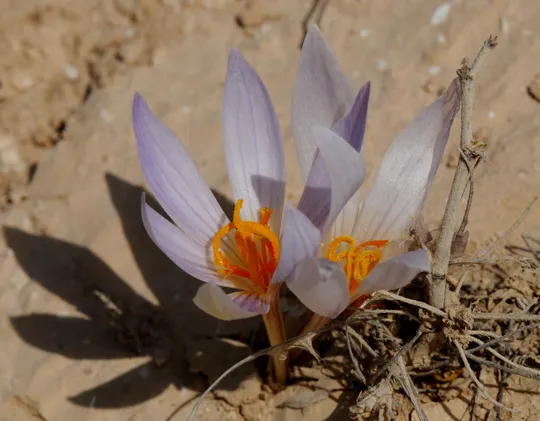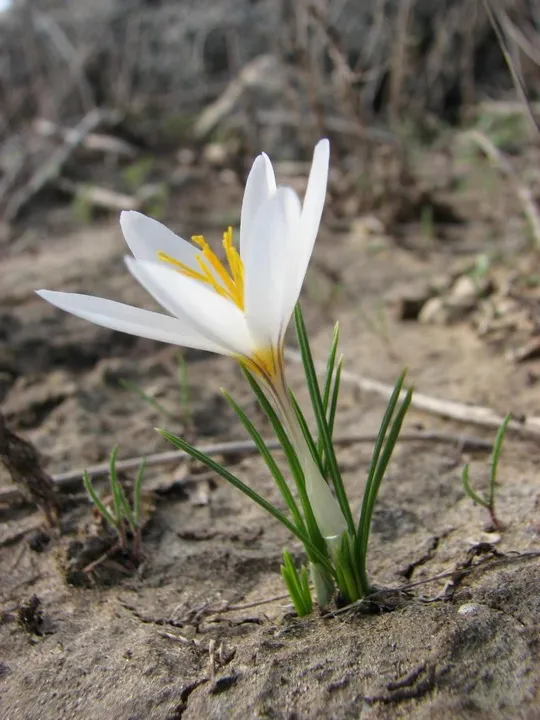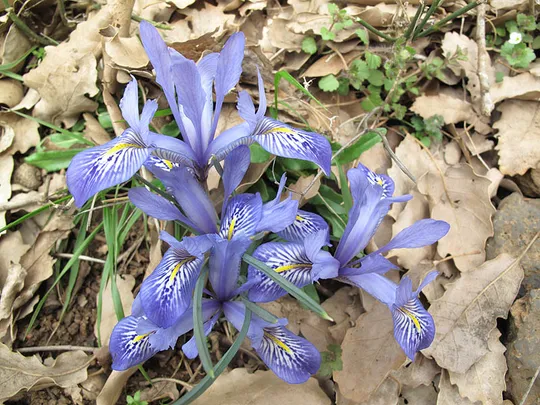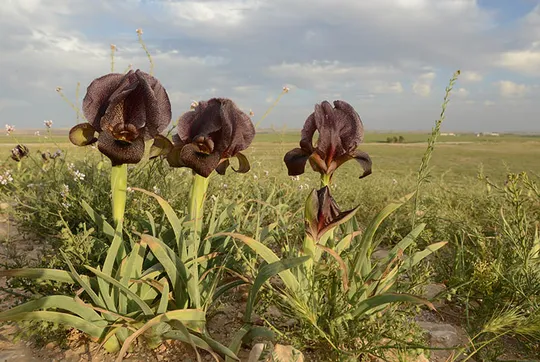Hermon Crocus
Crocus hermoneus
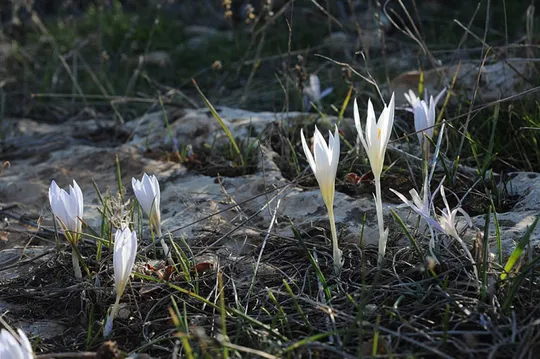
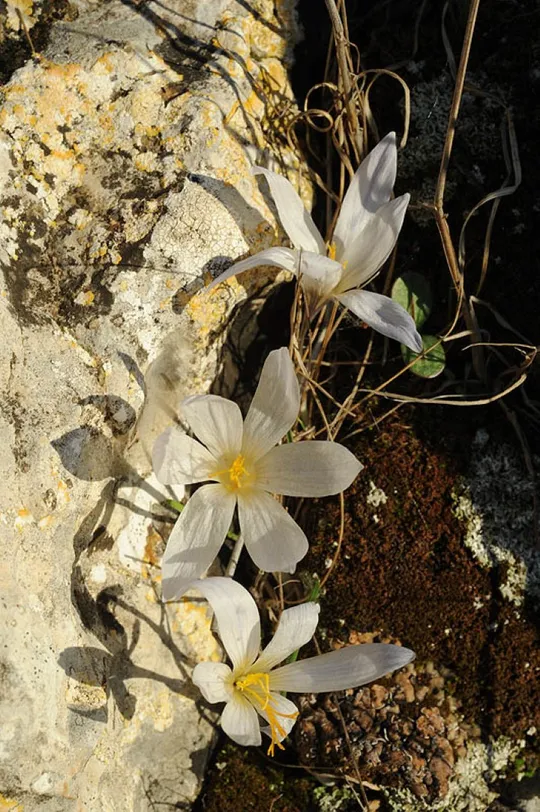
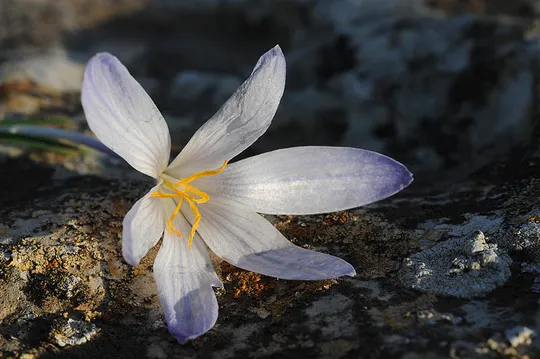
The Israeli subspecies of Crocus
hermoneus is endemic only to Samaria in the
Binyamin Mountains, from the area of Ramallah and Bet El up to Nebi Samu’el
north of the Ramot neighborhood in Jerusalem. It grows (as of 1987) in Bet El, the
Bet El IDF base, Judea and Samaria Junction, the outskirts of Qalandya, Giv'on Valley,
the village of Ǧedira, the village of Alǧib and Nebi Samu’el. In the past (1952-1968) was
probably common in Sanhedriya neighborhood in Jerusalem and was collected there
many times, but has definitely been extinct in Jerusalem since before 1972. The
plant was not found there in the 2000-2001 rare species survey.
Rocky slopes and
sunny scrublands on the mountains at an altitude above 800 meters, mostly on a hard
limestone substrate between rocks, but also on Sarcopoterium scrublands on
soft
chalk (Bet El army base).
The genus Crocus includes 90 species, found in
the Mediterranean, Euro-Siberian and Irano-Turanian regions. Its center of
diversity and speciation is located in the mountains of the Middle East and the
Balkans.
C. hermoneus was first described
in the nineteenth century following the excursion of the botanist Kotschy to
the summit of Mount Hermon. Kotschy collected only the corms, so for
years it was a mystery what the flowers looked like. Only after 1967 were flowers
collected from the population at the Mount Hermon summit, upon which it became
clear that the C. hermoneus was very close to the C. palaestinus.
This species was first found north of Ramallah in the West Bank in the area of
the Judea and Samaria Junction by Tuvia
Kushnir in 1942, and was described then as a new species. After 1967, it became
clear that it is very similar to the Mount Hermon populations (Feinbrun &
Shmida, 1977). Therefore, its taxonomic status was reduced to a subspecies, and
it was incorporated into C. hermoneus. In conclusion, in our region two
subspecies of C. hermoneus grow: on Mount Hermon – the subspecies hermoneus
and in Samaria – the subspecies palaestinus. The fragmented distribution
suggests that a colder and more humid period existed in the past, and that
climate change created fragmentation. The isolation following the fragmentation
led to differentiation and the development of the different forms of the species.
C. cancellatus (= C. damascenus)
is a very close specie to C. hermoneus; their flowers are identical, but
the corm fibers of the C. cancellatus are coarse and reticulate,
while the fibers of the C. hermoneus are delicate and parallel. On the
basalt cliffs of the southern Golan Heights near Mitzpe Haon there is a
transition population between the two species (Cohen and Schmida, 1988).
•
In the past Crocus
hermoneus grew on seven sites in the area between Bet El and Nebi Samu’el.
This area has undergone rapid development in the last twenty years, and at
least some of the populations observed in 1987 disappeared in the years
2000-2004. The population from which the species was first described in the Bet
El area is extinct following extensive construction. The Sanhedria population
in Jerusalem has been completely eradicated.
•
All the
surviving C. hermoneus sites are not located in nature reserves.
•
No thorough
survey has been conducted in the area. There is no information on population
sizes and how many have survived until today.
Crocus sites
in Samaria should be surveyed and mapped to estimate their population sizes.
The population of the Ha'On Peaks has to be investigated – to see whether it
belongs to C. cancellatus or to the C. hermoneus ssp.
palaestinus. A site in the Bet El -Giv'on Valley area should be declared a
reserve and this endemic subspecies should be monitored and protected in it.
Crocus hermoneus
is endemic to Lebanon, Israel and Jordan. The Hermon subspecies of Crocus
hermoneus is endemic to Mount Hermon and the anti-Lebanon mountain range.
It was described from the summit of Mount Hermon (Cohen and Schmida, 1988) and is
found today on the Hermon on rocky slopes and hilltops mainly at altitudes of 1700-2800
meters. In Jordan it grows on the high plateaus of Ammon (= al-Balka) and in
the Moab at altitudes above 800 meters.
Crocus hermoneus
is an endemic geophyte that grows only in the Binyamin area in Samaria. About half the sites have become extinct
because of construction and for unknown reasons. The subspecies palaestinus
has a southern peripheral distribution of C. hermoneus from Lebanon – a
clue to the geological-evolutionary history of our region. This is a species
that was found for the first time by an Israeli and described to science by an
Israeli scientist.
כהן, ע. ושמידע, א. 1988. צמחים נדירים בישראל – כרכום ארץ-ישראלי. טבע וארץ ל"א 3: 13-15.
Feinbrun, N. and Shmida, A. 1978. A review in the genus Crocus in Israel and neighbng countries. Israel J.of Botany, 26: 237-243.
Current Occupancy Map
| 1000 squre meter pixel | 5000 squre meter pixel | 10000 squre meter pixel | |
|---|---|---|---|
| number of observations | 0 | 0 | 0 |
| in total pixels | 0 | 0 | 0 |
| Family | Iridaceae |
| Classification | On the endangered species list |
| Ecosystem | Mediterranean, Tragacanthic |
| Chorotype | Eastern Mediterranean |
| Conservation Site | Judea and Samaria Junction near Bet El |
| Rarity |
1
3
6
|
|---|---|
| Vulnerability |
0
4
4
|
| Attractiveness |
0
2
4
|
| Endemism |
0
3
4
|
| Red number |
1
6.8
10
|
| Peripherality | N |
| IUCN category | DD EW EX LC CR EN VU NT |
| Threat Definition according to the red book | Critically endangered |
 Based on:
Based on:
